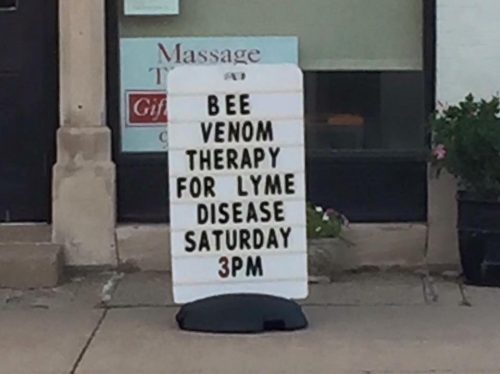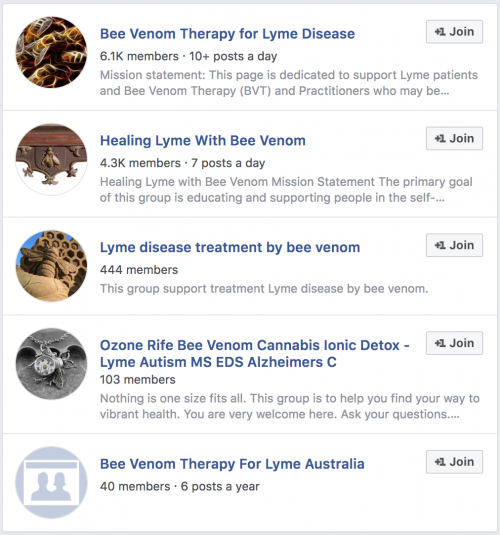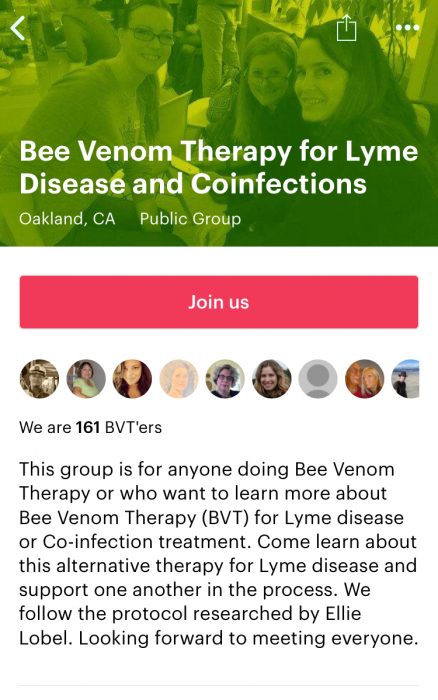Bee venom therapy (apitherapy or BVT) is a fad treatment that involves stinging oneself with bees. BVT is one of the many forms of quackery used in the chronic Lyme world.
In a 2015 scientific review, BVT was among 30 “unorthodox” Lyme therapies without evidence for efficacy.
Table of contents
No benefit, All risk
There is no compelling scientific evidence to support BVT as a treatment for pain or any disease, but it carries serious risk of anaphylaxis and other side effects.
Actor Gerard Butler was hospitalized after bee venom therapy sent him into anaphylactic shock, not once but twice!
Quick info
| Adverse events with bee venom therapy: | Frequent |
| Number of diseases helped by bee venom therapy: | 0 |
| Number of people killed by bee venom therapy: | At least 2 |
How bee venom therapy kills
BVT is sometimes administered by acupuncturists. In 2018, doctors in Spain documented the death of a 55 year old woman who had been receiving bee venom acupuncture every four weeks for two years.
Also in 2018, a school teacher in her 30s died of anaphalaxis after being treated with bee venom acupuncture.
According to an article by Dr. Robert Glatter:
While bee venom does contain an anti-inflammatory compound known as melittin, medical studies have not provided any convincing evidence that this component is efficacious in alleviating pain or in treating the purported medical conditions.
What is clear is that the chance for adverse reactions–skin rashes, allergic reactions, and anaphylaxis–to bee venom increases the longer such acupuncture therapy is administered.
This might seem counterintuitive, but with each session there is a greater chance of having a more severe reaction, including anaphylaxis —a dangerous drop in blood pressure and massive airway swelling which is fatal.
The irony: Bees kill much more often than Lyme disease
Dr. Richard Gunderman calls bees “America’s most lethal animal.” In 2018, scientists found that hornets, wasps, and bees were responsible for about 220,000 visits to the emergency department and 60 deaths every year.
While bee deaths are rare, deaths associated with Lyme disease are even more rare. One study found fewer deaths in Lyme patients than typical Americans, a year after diagnosis. LymeScience’s literature review found 13 reliably reported deaths associated with Lyme disease from the 1970s to 2019.
Misinterpreted research
Sometimes advocates will point to sciency-sounding studies as providing proof that bee venom therapy works. There have been at least two studies showing melittin might kill Lyme bacteria in a petri dish, but there is no evidence it is effective in humans for any disease.
One misleading study was performed by a group at University of New Haven led by Eva Sapi. Eva Sapi received a diagnosis of chronic Lyme disease herself and seems to be dedicated to legitimizing the unrecognized diagnosis.
Sapi receives substantial publicity and financial support from chronic Lyme pseudoscience groups. The Sapi study discloses donations from several anti-science groups, including Lymedisease.org, Focus on Lyme, and Global Lyme Alliance.
Plenty of substances, such as bleach, can kill bacteria in a petri dish. Such results are not necessarily applicable to humans. Furthermore, there is already a cure for Lyme disease, so searching for new treatments is not a high priority.
Discussing whole bee venom and melittin, the Sapi study admits:- “the findings from this in vitro study cannot be applied directly to clinical practice”
- “further research is necessary to evaluate their effectiveness in vivo, as well as their safe and effective delivery method for their therapeutic use.”
In other words, the Sapi paper is careful to acknowledge the lack of scientific evidence that bee venom can safely treat diseases in humans.
Bad medical advice spreads via social media and “support” groups
If you go to a chronic Lyme support group meeting, someone might say they felt better with BVT. Or if you’re in a Facebook group, someone might sing the praises of the bizarre practice.
The NIH has reported that as high as 40% of patients receiving placebo had a positive response. In other words, a fake treatment (placebo) may seem to be effective when it is not having any effect.
A site called “LymeWarrior.us” claims with no compelling scientific evidence, “Bee venom therapy targets all forms of Lyme bacteria.” Despite having a known bee sting allergy, a woman featured on Lyme Disease UK stung herself with bees and reported improvements.
Thousands of people have gathered in Facebook groups that legitimize both chronic lyme disease and bee venom therapy. There is even a group for Australians, even though there is no Lyme disease in Australia.
TikTok has also served to falsely claim that bee venom cures Lyme disease.
There was a Meetup group in Oakland, CA called Bee Venom Therapy for Lyme Disease and Coinfections with 161 members as of May 1, 2018. However, in 2016, there were only 90 confirmed cases of Lyme disease reported in California .
Resources:
Dr. Nikki Stamp and Pixie Turner: (Un)Well 05: Bee Stings: The Bees Knees? 🔊
Lantos PM, et al. Unorthodox alternative therapies marketed to treat Lyme disease. Clin Infect Dis. 2015;60(12):1776-82.
Robert Glatter, MD: Bee Venom Acupuncture: A Therapy That Could Kill You
Clay Jones, MD at Science-Based Medicine: A Woman Dies from a Severe Allergic Reaction After Live Bee Acupuncture Session
David Gorski, MD: Bee venom acupuncture: Deadly quackery that can kill
Forbes: Bee Acupuncture: Death Would Be One Reason Not To Get It
Skeptics Guide to the Universe: Beware The Honey Trap: Gwyneth Promotes Bee Venom Therapy
The Guardian: Gerard Butler: I injected myself with bee venom and ended up in hospital
SELF Magazine: Gerard Butler’s Bee Venom Therapy Sent Him into Anaphylactic Shock
Vazquez-revuelta P, Madrigal-burgaleta R. Death due to Live Bee Acupuncture Apitherapy. J Investig Allergol Clin Immunol. 2018;28(1):45-46.
Park JH, et al. Risk associated with bee venom therapy: a systematic review and meta-analysis. PLoS ONE. 2015;10(5):e0126971.
Adamic K, et al. The local and systemic side-effects of venom and inhaled-allergen subcutaneous immunotherapy. Wien Klin Wochenschr. 2009;121(9-10):357-60.
Lubke LL, Garon CF. The antimicrobial agent melittin exhibits powerful in vitro inhibitory effects on the Lyme disease spirochete. Clin Infect Dis. 1997;25 Suppl 1:S48-51.
Socarras KM, Theophilus PAS, Torres JP, Gupta K, Sapi E. Antimicrobial Activity of Bee Venom and Melittin against Borrelia burgdorferi. Antibiotics (Basel). 2017;6(4)
Richard Gunderman, MD: America’s most lethal animal
Forrester JA, et al. An Update on Fatalities Due to Venomous and Nonvenomous Animals in the United States (2008-2015). Wilderness Environ Med. 2018;29(1):36-44.
Dr. Edzard Ernst: Bee venom acupuncture? No thanks!
ALS Untangled: Assessment of Bee venom for ALS
Articles by Dr. Steven Novella, a Yale neurologist who founded Science-Based Medicine:
- Bee Venom Therapy (2002)
- Bee Venom Therapy – Grassroots Medicine (2008)
- Bee Venom Therapy Update (2012)
- Ben Venom is Snake Oil (2018)
Updated May 23, 2024


